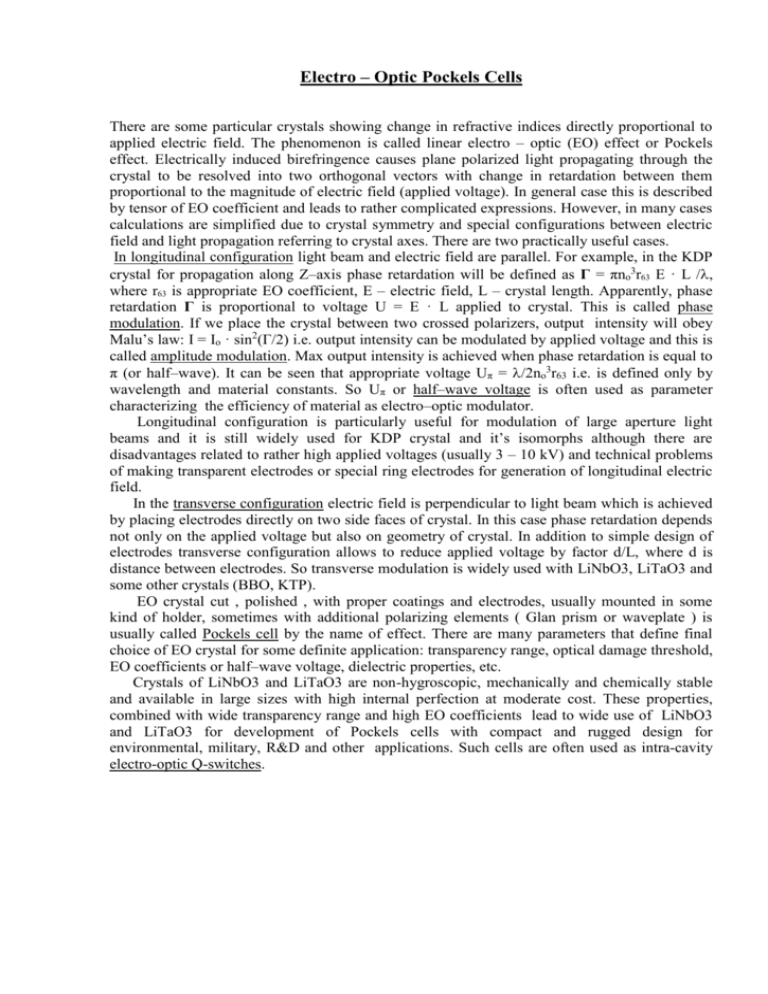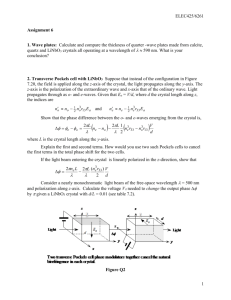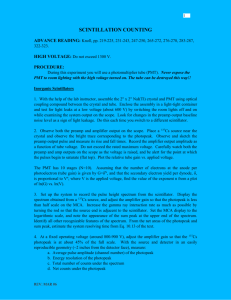Electro – Optic Pockels Cells
advertisement

Electro – Optic Pockels Cells There are some particular crystals showing change in refractive indices directly proportional to applied electric field. The phenomenon is called linear electro – optic (EO) effect or Pockels effect. Electrically induced birefringence causes plane polarized light propagating through the crystal to be resolved into two orthogonal vectors with change in retardation between them proportional to the magnitude of electric field (applied voltage). In general case this is described by tensor of EO coefficient and leads to rather complicated expressions. However, in many cases calculations are simplified due to crystal symmetry and special configurations between electric field and light propagation referring to crystal axes. There are two practically useful cases. In longitudinal configuration light beam and electric field are parallel. For example, in the KDP crystal for propagation along Z–axis phase retardation will be defined as Г = πno3r63 E · L /, where r63 is appropriate EO coefficient, E – electric field, L – crystal length. Apparently, phase retardation Г is proportional to voltage U = E · L applied to crystal. This is called phase modulation. If we place the crystal between two crossed polarizers, output intensity will obey Malu’s law: I = Io · sin2(Г/2) i.e. output intensity can be modulated by applied voltage and this is called amplitude modulation. Max output intensity is achieved when phase retardation is equal to π (or half–wave). It can be seen that appropriate voltage Uπ = /2no3r63 i.e. is defined only by wavelength and material constants. So Uπ or half–wave voltage is often used as parameter characterizing the efficiency of material as electro–optic modulator. Longitudinal configuration is particularly useful for modulation of large aperture light beams and it is still widely used for KDP crystal and it’s isomorphs although there are disadvantages related to rather high applied voltages (usually 3 – 10 kV) and technical problems of making transparent electrodes or special ring electrodes for generation of longitudinal electric field. In the transverse configuration electric field is perpendicular to light beam which is achieved by placing electrodes directly on two side faces of crystal. In this case phase retardation depends not only on the applied voltage but also on geometry of crystal. In addition to simple design of electrodes transverse configuration allows to reduce applied voltage by factor d/L, where d is distance between electrodes. So transverse modulation is widely used with LiNbO3, LiTaO3 and some other crystals (BBO, KTP). EO crystal cut , polished , with proper coatings and electrodes, usually mounted in some kind of holder, sometimes with additional polarizing elements ( Glan prism or waveplate ) is usually called Pockels cell by the name of effect. There are many parameters that define final choice of EO crystal for some definite application: transparency range, optical damage threshold, EO coefficients or half–wave voltage, dielectric properties, etc. Crystals of LiNbO3 and LiTaO3 are non-hygroscopic, mechanically and chemically stable and available in large sizes with high internal perfection at moderate cost. These properties, combined with wide transparency range and high EO coefficients lead to wide use of LiNbO3 and LiTaO3 for development of Pockels cells with compact and rugged design for environmental, military, R&D and other applications. Such cells are often used as intra-cavity electro-optic Q-switches. Brief description of applied transverse configurations for these crystals is given below: Light E-field orientation Propagation ║ Z axis ║ X or Y axis ║ X axis ║ Z axis Del Mar Photonics, Inc. 4119 Twilight Ridge San Diego, CA 92130 tel: (858) 876-3133 fax: (858) 630-2376 sales@dmphotonics.com Birefringence Half–wave voltage Uπ Δn= no d . _________ L ne3r33 - no3r13 - ne + 3 + ( ne r33 - no3r13)/2 Δn= no3r22 E d L . _____ 2no3r22 Uπ for LiNbO3 @ 632.8 nm, L=d 3 kV 4 kV











